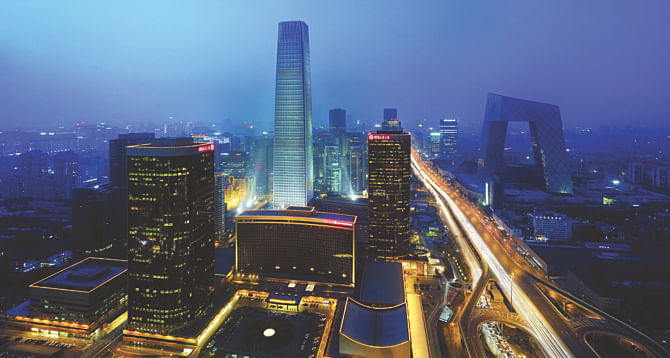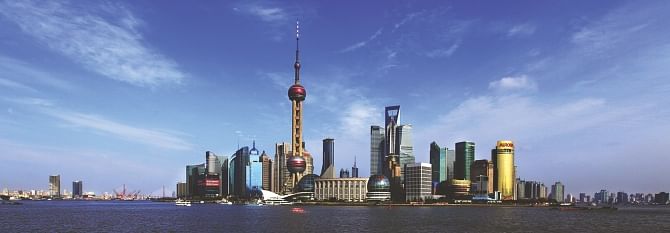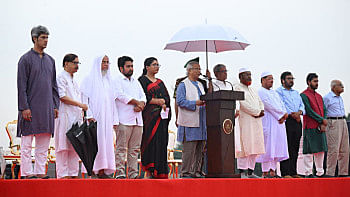Maritime Silk Road and Economic Belt: Emerging opportunities for Bangladesh

China was well-connected with its immediate neighbours as well as Europe, Middle East and Africa through the Silk Road for centuries. There were two components of the Silk Road- Overland Silk Road (OSR) and Maritime Silk Road (MSR). The former can be traced back to the Han Dynasty around 200 BC stretched over 10000 km from Xi'an to Rome. Originated in China, the Maritime Silk Road is arguably the earliest voyage route covering vast areas of numerous oceans and seas- from South China Sea to Indian Ocean and the Persian Gulf.
Beijing now intends to revive the ancient Silk Roads connecting history with the future. China was for a large part of the last two millennia the world's largest economy. However, the importance of silk routes diminished following China as well as Asia's economic decline. As an emerging superpower of the 21st century, China, at present, wishes to reestablish the old trade and cultural routes.
The push to rebuild Silk Roads, nevertheless, comes from the new leadership in Beijing that emphasises on China's 'peaceful rise' promoting a stable Asia Pacific. Moreover, the new policy, according to some Sinologists, is also in line with the 'Chinese dream' that underscores shared prosperity. Beijing hopes that covering more than 20 countries and regions, the 21st century Maritime Silk Road will extend southward from China's ports, through the South China Sea, the Straits of Malacca, Lombok and Sunda and then along the north Indian Ocean to the Persian Gulf, Red Sea and Gulf of Aden.
Based on the principle of mutual benefits, the plan also connects the Silk route economic belts. A number of economic corridors are planned in China's immediate neighborhood- the Bangladesh-China-India-Myanmar economic corridor (BCIM EC) and China-Pakistan economic corridor are in the making. Economic corridors provide connection between economic nodes or hubs, in which large amounts of economic resources and actors are concentrated.

Bangladesh was historically well connected with both OSR and MSR. The Chinese traders arrived in Chittagong port in the 7th century when the fabulously rich kingdom by the name of Harikela thrived on the bank of the Karnaphuli River. Famous Chinese Admiral Zheng He led the Imperial Mission to the Sultanate of Bengal at least twice in the 15th century and anchored in Chittagong port. Until the colonial intrusion into the Bay in the late 18th century, the northern Bay lands were noteworthy for Bengal's economic growth serving a vast hinterland, including the Shan states and Yunnan of China.
China's plan to revive the MSR and development of economic belts offer immense opportunities for Bangladesh. The plan of 21st century MSR coincides with Bangladesh's demarcation of its maritime boundary with two of its Bay of Bengal neighbours- India and Myanmar. This gives the country an opportunity to build a blue economy in the world's largest Bay. Some of the key components of its ocean economy should include energy security (oil and gas resources), fishery and fresh water resources preservation, port and logistic facilities development, piracy and illegal trade control, trade route securing, tourism development and ecosystem protection, inter alia.
However, given the massive undertaking, it requires involvement of regional as well as global powers to develop a modern ocean economy. Bangladesh has to develop a deep-sea port to meet the demand of its domestic economy as well as to cater in vast regional hinterland, changing the economic geography of the region.
Moreover, the maritime cooperation is also needed to deal with non-traditional security threats such as climate change, piracy and illicit drug trafficking that have cross-border implications. The littoral surrounding of the Bay of Bengal in particular is vulnerable to climate change. China has expanded maritime cooperation in the area of ocean and climate change, marine disaster prevention and mitigation and biodiversity preservation with a number of Southeast Asian and South Asian countries. The China-ASEAN Marine Cooperation Center, the Indonesia and China Center for Ocean and Climate, the China-Pakistan Joint Marine Center and the China-Sri Lanka Marine and Coastal Zone Joint Research Center are some examples of how the MSR regions have amplified maritime cooperation. Dhaka should forge similar partnership.
Bangladesh's involvement with China, India and other neighbouring countries to develop economic corridor is equally important to spur its manufacturing growth. South Asian economies risk bypassing industrialization, leapfrog from agriculture to the services sector. Given the lower concentration of manufacturing activities, South Asia is largely non-existent in the Global Value Chains, an important phenomenon of regional economic integration along economic corridors in Asia. Southeast Asia, for instance, holds an eight percent share of global production network exports, whereas South Asia's share is less than one percent. Bangladesh's per capita manufacturing value-added is only $108, compared to China's $1147. Bangladesh could narrow its manufacturing catch-up gap by drawing low-end labour intensive industries that are hollowing out from the east coast of China.
Moreover, China is projected to buy about $20 trillion worth of goods and services by 2020 as it redefines its growth model with greater concentration on consumption led growth. It could become one of the leading export markets for Bangladesh and other South Asian economies provided the manufacturing sector is strengthened drawing investment and technology in industrial parks.
The BCIM EC could offer an institutional framework to harness economic complementarities that exists among member economies. The forthcoming meeting of the second joint working group of BCIM, scheduled to be held in Cox's Bazar, is expected to make consensus of signing a BCIM Framework Agreement.
Practicing the principles of 'seamless connectivity' and 'open regionalism', most East and Southeast Asian nation are now well-integrated. However, South Asia is laggard in this regard. If regional cooperation takes a firm footing under the aegis of BCIM, it, along with the Greater Mekong Subregion (GMS), South Asia Subregional Economic Cooperation (SASEC) and Central Asia Regional Economic Cooperation (CAREC), could act as the building block for pan-Asian regionalism facilitating a single market in Asia.
That said, there is no precedence in history that the Silk Road was used by China or other powers to achieve their territorial ambitions. It was largely a trade route that promoted cultural and people-to-people connection. Thus, the OSR and MSR could become the road to prosperity for Bangladesh. By effectively joining the 21st century Maritime Silk Road and BCIM economic corridor Bangladesh could develop an ocean economy in the Bay of Bengal and become a manufacturing nation. To make this happen, Dhaka needs both bilateral and regional efforts in order to accelerate cooperation with Beijing.
The writer is a research fellow at the BRAC Institute of Governance and Development (BIGD), BRAC University, Email: [email protected]. The views expressed in this article are those of the author.

 For all latest news, follow The Daily Star's Google News channel.
For all latest news, follow The Daily Star's Google News channel. 



Comments